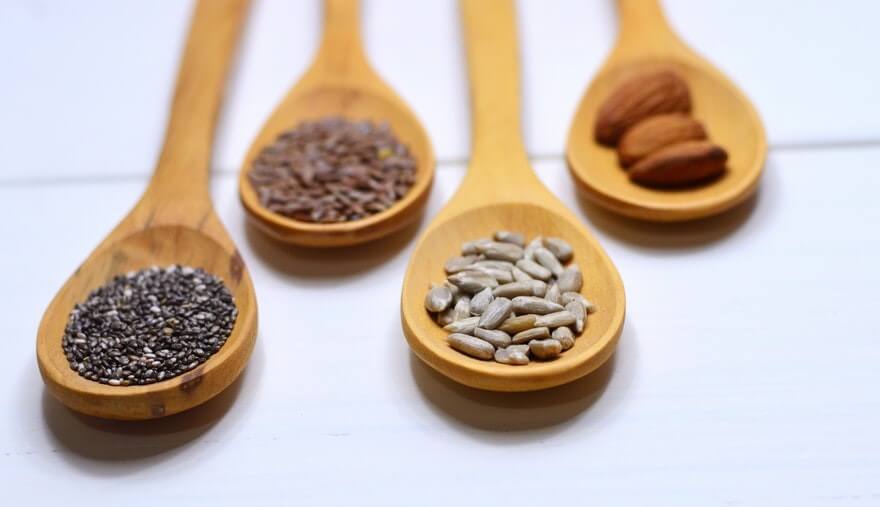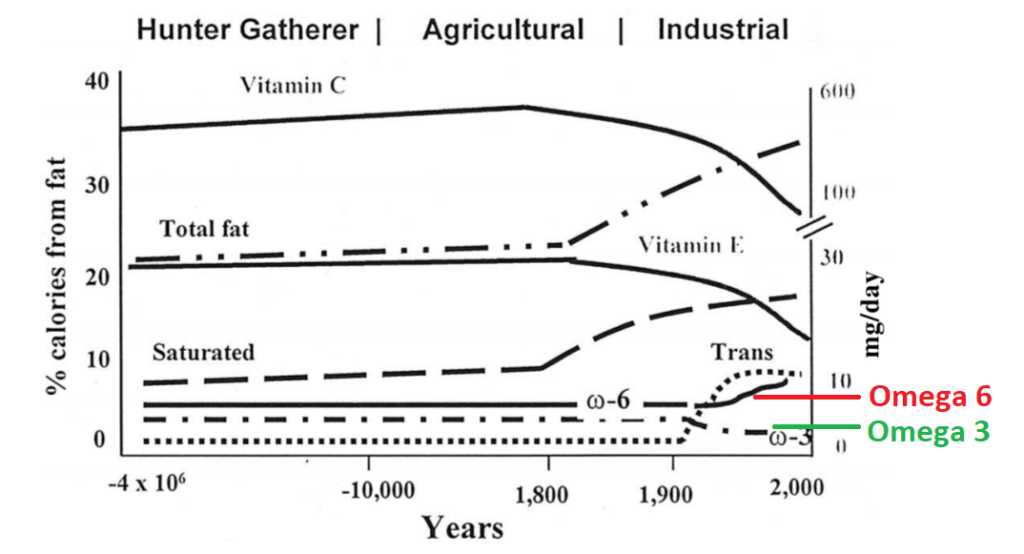
Seeds are one of the best vegan sources of fats, and also a great vegan source of calcium.
After making a page about the ratio of omega 3 to 6 fats in nuts, it only made sense to do the same for seeds.
I collected basic nutritional data for all the common seeds I could think of, and the results are just below.
If there are any seeds that I forgot, just let me know and I’ll add them.
Table of Contents
Omega 3:6 Ratio of Seeds Table
The table below shows the fat breakdown in 100 grams of each common seed. The most important column of this table is the one on the far right.
In general, you want this ratio to be as high as possible.
| Seed | Fat in 100g | Omega 3 (g) | Omega 6 (g) | Omega 3:6 ratio |
|---|---|---|---|---|
| Flax | 42.2 | 22.81 | 5.91 | 3.8596 |
| Chia | 30.8 | 17.55 | 5.79 | 3.0311 |
| Hemp | 50 | 8.33 | 30 | 0.2777 |
| Sesame | 49.7 | 0.38 | 21.37 | 0.0178 |
| Pumpkin | 19.4 | 0.077 | 8.6 | 0.0090 |
| Sunflower | 51.5 | 0.074 | 23.05 | 0.0032 |
Both flax and chia are amazing sources of plant-based omega 3 fats.
But there’s a big difference between certain types of seeds. Sunflower and pumpkin seeds barely have any omega 3 fats. Their ratio is closer to the typical nut rather than flax or chia seeds.
Flax, chia, and hemp seeds all have a “good” omega 3 to 6 fat ratio, and also have a high raw quantity of omega 3 fats.
What’s the Ideal Omega 3 To 6 Ratio?
Studies show that humans historically ate a diet with a omega 3:6 ratio of approximately 1 (source).
On the other hand, the omega 3:6 ratio of modern Western diets is more like 1:15, which is responsible for chronic inflammation and many resulting health consequences.
You can start to see where the ratio went haywire in the graph below:
Back to our seed data, we can conclude a few things:
- Chia and flax both have great ratios of omega 3 to 6 fats. Many vegan recipes high in omega 3 fats contain them.
- Hemp has a decent ratio of omega fats; most research seems to suggest you want at least a 1:4 ratio (0.25 in our table above), so hemp just beats this cutoff. Hemp also has a pretty good amino acid profile.
- Other seeds aren’t so great – When it comes to the other seeds, they’re clearly not good sources of omega 3 fats. You should limit your intake of sesame, pumpkin, and sunflower seeds.
Seeds have a much better ratio than nuts for omega 3s and 6s, but certain ones are clearly better than others.
How Much Omega 3 Fat Do You Need?
It can be tempting to think “I’m going to eat so much flax to get a ton of omega 3 fats and be super healthy”.
But the benefits of omega 3 fats taper off pretty quickly if you already have a good balance of omega 3 to 6 fats.
The current RDA from the NIH says that adult males need the most omega 3 fats and should aim for 1.6 grams of omega 3 fats per day.

This table is already in terms of ALA, which is the plant-based form of omega 3s that you will find in seeds.
Getting a few tablespoons of seeds high in omega 3 fats like chia or flaxseed is more than enough omega 3 fats in most cases.
Can You Get Too Much Omega 3 Fat?
While there’s an upper limit of how much of omega 3-rich foods like fish that people should eat (due to mercury in the case of fish), there aren’t any known issues with eating excess omega 3 fats from healthy plant sources.
So while there may be an upper limit to how much flaxseed you should eat in a day before starting to feel sick, most people don’t need to be worried about getting too much omega 3 fats.
Other Ways to Get Omega 3 Fats
If you eat a lot of those “bad” seeds, you can attempt to balance out your polyunsaturated fat intake by getting more omega 3s from other sources.
If you eat fish, that’s the best source.
If you don’t for whatever reason, an algae-based vegan omega 3 supplement is a good alternative that is the easiest way to get omega 3s from plants. It’s really the only other realistic option on a plant-based diet.
Limit, But Don’t Eliminate Seeds
While you don’t want to go overboard on certain seeds, they are all packed with nutrients.
For example, sunflower seeds are the best plant-based source of vitamin E, while pumpkin seeds have a lot of zinc and magnesium.
Eat a variety of seeds if possible, just don’t overdo it.


Thanks for your sage advice. I learned a lot
This is such a helpful resource — oMEGA useful, if you will, haha. Thank you!
🙂
Thank you for the wonderful news and sound advice about omega rich sources from seeds and their quantities.
You’re welcome 🙂
Thank you. These charts for the nuts and seeds were very beneficial for me. I am currently eating a raw veggie diet with smoothies containing cruciferous leafy greens to reverse my auto immune disease(s), lupus and sjogren syndrome found at goodbyelupus dot com. Dr. Brooke Goldner Tadlock says to put flax seeds and/or chia seeds in the smoothies everyday. And it’s good to know Flaxseed and Chia seeds are at the top for Omega 3s. No other nuts are allowed because of the high omega 6 content.
I was actually searching for another seed recommended, aliv seed to help with my hair loss (from lupus). Soak the seeds for 8 hrs and drink in milk or alternative milk. It is supposed to help reverse and bring back hair growth. But, I didn’t want to take it if it has large quantity of Omega 6 or other things not good for inflammation. Thanks for your info. -Lin
I’m grateful to you for making this helpful information so accessible. I have found that the majority of sites list the ratio as omega 6:omega 3 (not omega 3:omega 6, as you do. For that alone, it took this old brain a bit longer to process (I need more omega 3 fats for brain health, I think!). I know I could just calculate the ratio myself because you list it clearly in your charts & text, but was wondering why you chose to do it that way? When I first heard about the importance of this ratio, I actually wondered why all of the sites listed the omega 6 first (after all, 3 comes before 6, and I already knew about omega 3 fats), but I think it’s because the ratio is easier to understand when the higher value comes first.
Thank you again for taking the time & effort to share this important information.
No particular reason.
Omega 6: Omega 3 probably makes more sense actually, that’s how it’s presented in most research. But you’re right, either should work, and I guess I subconsciously prefer to think about maximizing omega 3 intake versus the opposite.
Love the table – thank you. Could you share your source regarding the % calories from fat vs time?
Also saw your nut table, but how about plant sources? There are only 3 seeds that provide a acceptable or better and no nuts – so how does one get an acceptable ratio unless they have access do those seeds and/or seaweed/algae?
Thanks!
If you’re talking about the graph, the source is the study linked to a few sentences before.
As to getting an acceptable ratio, you either limit your consumption of most oils and processed foods, and/or you take an omega 3 supplement.